SUF: 4DP and Training Plans
This is the third article in a three-part series on SUF. The first article was a brief history of SUF, and the second was an overview of the entertainment value and ease-of-use of the app. This article gives some insight into how the 4DP system and training plans work in SUF.
What Training Plan to Pick?
There is a common dilemma faced by endurance athletes who want to enter the realm of structured training towards a goal: how to put together a training plan and plan the season. There are myriad books and online training plans. And for those willing to invest significant money, plenty of options in personal coaching. Navigating those choices can be challenging, even for lifelong athletes. And almost every aspect is controversial, at least if the Slowtwitch forums are any indication. There is little agreement on how to test, or what percentage of training should be “easy” vs. “hard.” What makes one plan or methodology better than another? Particularly given the enormous variability between people. How do you measure how your training is going?
Solutions to this problem range from free cookie-cutter online training plans to relatively costly fully customized personal coaching. In between there’s a hybrid solution that’s starting to emerge: training plans that are automatically customized without any expensive human labor involved. There are two parts to this customization. The first part is an initial setup process, that usually involves filling out a form with a lot of questions about what your goals are, who you are, how much time you have, etc. Once you answer all those questions you get a nice training calendar tailored to your responses. The second part is monitoring your progress and adjusting according to your adaptation – so that your training is challenging, but not overwhelming. In cycling, this adjustment has historically been achieved with the help of the functional threshold power (FTP), and other convenient metrics. Innovations in cycling power meter use (thank you Banister, Coggan, et al.) brought power-based training methodology into the mainstream. The combination of smart trainers, ubiquitous power measurement, and intelligent software makes this automation of training and testing increasingly attractive and easy-to-use. SUF is far from alone in exploring this space. The likes of TrainerRoad, PKRS, Reddiyo, Xert and others offer variations on the automated training plan. This article will examine SUF’s strengths, weaknesses, and what makes it different.
The 4DP Profile
Before diving into the details of setting up a training plan, it’s important to be introduced to the concept that underpins SUF’s training methodology: the four-dimensional power profile, or 4DP. Within the SUF-umbrella, 4DP replaces the venerable FTP test in the role of measuring the state of a cyclist’s fitness – in addition to identifying rider type, another emerging feature among cycling training apps. 4DP adds three additional measures of performance to FTP: maximal aerobic power (MAP), anaerobic capacity (AC), and neuromuscular (NM) power. For a detailed definition and explanation of 4DP, I suggest heading over to thesufferfest.com. But, roughly speaking, while FTP is a performance measure of the maximal power a cyclist can produce for about an hour, MAP is that value for a 20-minute effort, AC for a 1-minute effort, and NM for a 5-second effort. A snapshot of the four numbers together, according to SUF, give a more complete signature of who you are as a cyclist than FTP alone.
This is one of those things that may be considered controversial within Slowtwitch or other forums. FTP is an entrenched metric. And for good reason – it’s proven. And why would a triathlete care about a 1-minute or 5-second effort? I’m not qualified to give a hardcore scientific defense of 4DP vs. FTP, but I’ve included some links at the bottom of this article for some scientific and empirical validation of the use of performance profiles. And I can give a non-scientific rationale for why a performance profile might be useful. First – though the measurement of maximal power for durations shorter than an hour might not help a triathlete predict race performance, most triathletes, I presume, use shorter intervals in training. For example “VO2 intervals” of around 5 minutes are a common feature of numerous training plans. And determining a good effort level for those intervals is important. Two athletes with the same FTP might perform differently very differently on shorter training intervals. Some training plans simply specify intervals of all lengths as a percentage of FTP, e.g. defining a 10-second neuromuscular sprint effort as 200% FTP.
That may be a good rule of thumb. But more precise scaling, specific to who you are, might be more useful. 200% might not challenge one athlete while another may be unable to complete a single interval. Another good reason for power profile scaling is that there’s a trend in cycling over the past few years: cyclists of all types are broadening their range. Gravel and indoor cycling are becoming mainstream. And both of these forms of cycling typically feature higher wattage, lower duration efforts. Anyone who’s spent much time trying Zwift mass start races understands the value of good 1-minute power. Your exceptional FTP won’t do you much good if you’re all alone off the back just one minute into a race. Same with anyone who’s ever raced through a lengthy sand pit or up a steep ramp on a gravel ride. It may make sense to explicitly measure and train performance over these shorter duration efforts.
Testing in SUF
How is 4DP determined? By a combination of two SUF workouts: the Full Frontal and the Half Monty. Full Frontal directly measures the MAP, AC, and NM values with 5-minute, 1-minute, and 7-second efforts. While FTP is estimated from a 20-minute effort – a typical way to estimate FTP without a pure 40K or hour-long effort. Half Monty is a newer test that only measures FTP and MAP. And the maximal intervals are replaced with a ramp test and a sub-threshold interval. SUF’s guidance is to perform Full Frontal relatively infrequently, maybe at the beginning and ending of a season. The Half Monty is performed more frequently, with the rationale that it’s less physically and psychologically demanding. Though, in my opinion, it’s still fairly demanding. Ramp tests can be near the end, and the 20-minute “sub-threshold” effort in the Half Monty is barely sub-threshold. The sub-threshold interval keeps you at a dynamically calculated lactate threshold heart rate (assuming you’re testing with a heart-rate monitor). It’s still a pretty darn tough effort, particularly after a ramp test. SUF claims the Half Monty is the most accurate ramp-style test there is. Maybe it is, though that’s tough to verify. I’ve only done one Half Monty test so far, and it was significantly tougher and more time-intensive than a TrainerRoad or Zwift ramp test. It’s tough enough that in my own training I might consider just doing Full Frontal anyway and getting an update on the entire 4DP profile.
Here’s a brief walkthrough of some of my 4DP results: full disclosure, I didn’t perform these as frequently over the years as a Sufferlandrian should. I’m a 40K time-trialist, so I use real-world races as my performance tests, and often skip the indoor testing. I also went through long periods of using TrainerRoad’s ramp test when I wanted an indoor test. But what I have is shown here – you get a nice “passport” graphic of your 4DP metrics and their relative strengths, as well as visualization of your testing history so you can track progress (or regression). The LTHR (Lactate Threshold Heart Rate) is missing in my example here because I did not properly finish the Half Monty test that I took.
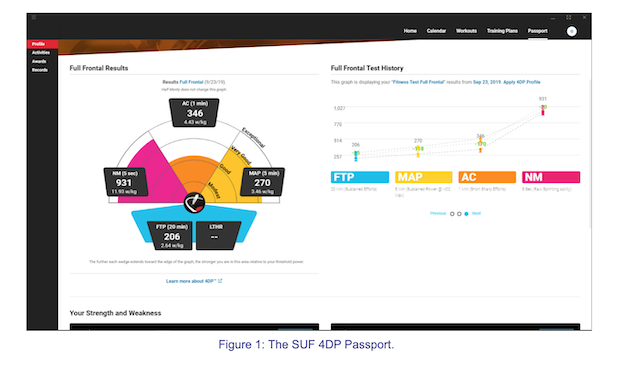
SUF also assigns you a “Rider Type,” and has designated me a “Pursuiter.” Which is nice because I was training for pursuit when I last took the Full Frontal test. The Rider Type designation isn’t just for fun, but also helps identify workouts and plans going forward. If you’re not the type you thought you were – or want to be – it’s a useful signal that you might need a change in your training plan, and focus more on workouts directed at improving the power durations indicated by the type you’re aiming for. This identification of type isn’t unique to SUF,and is prevalent in other indoor training apps and analysis tools – though methods vary.

After you complete a given workout, there is useful and clear presentation of what you did, along with basic power metrics like Training Stress Score (TSS), Intensity Factor (IF), and graphs of power, cadence, heart rate, “power bests,” and the 4DP profile that was used in that workout (more on this below). This summary is handy when repeating the same workout. This is similar to most indoor training apps.
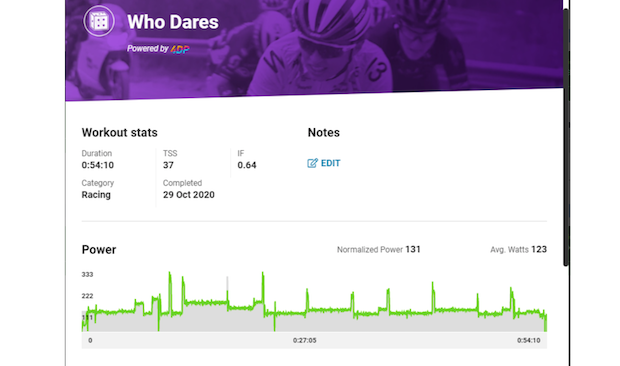
Training Plans
Now, finally, on to training plan generation. You start by selecting amongst a broad spectrum of basic plan profiles for roadies, triathletes, off-season, gravel, MTB, etc. Each with its own sub-categories. There are over 40 options covering just about everyone who might throw a leg over a bike, indoors or outdoors. The below figure shows an example of a 16-week “full distance” triathlon plan. And within a plan, there are a lot more options, like level (e.g. intermediate, advanced), inclusion of outdoors workouts, whether to schedule strength, yoga, or mental toughness training (covered in the 2nd article in this series), and a start and finish date.
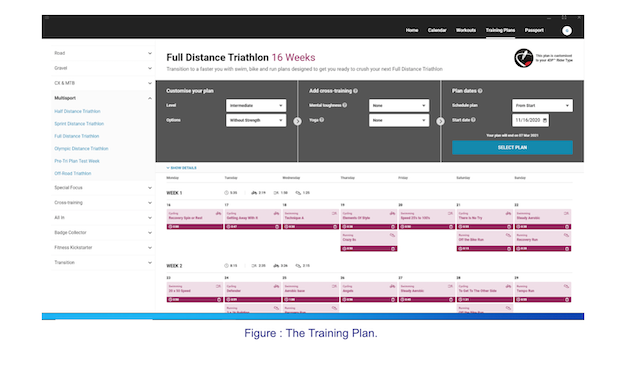
There are a good number of limitations. I’ll enumerate a few here:
- Plan length is fixed, either at 12 or 16 weeks in most cases (transition plans are one exception).
- You cannot change the beginning or end dates of a plan once started.
- There is limited ability to change what the plan generates – you can change the date of individual workouts one at a time, but that is about the extent of it.
- You cannot download outdoor rides to a head unit (yet).
- You cannot upload outdoor rides (yet).
If the inclusion of outdoor rides is selected, it assumes you always ride outdoors on Saturday and Sunday.
But, overall, you get a clearly scheduled set of workouts. To the right of each week is a summary of “planned” and “actual” hours for every week. Scanning through the generated training calendar lets you easily notice the block periodization method: you’ll get either two or three “high volume” weeks, followed by a “recovery” week. You get the two higher-volume weeks if on a 12-week plan, and the tougher three weeks if on a 16-week plan. The higher volume plans, SUF says, are for younger, more experienced, or faster-recovering athletes. Here is an example of one of the high volume weeks on my current plan.

Green represents completed workouts. I skipped the still-gray mental training workout – though I highly recommend them – because I have no races anywhere on my horizon, and it’s hard for me to focus well on those sessions without a concrete goal. Though after my last few performances on the Slowtwitch Zwift team, maybe I should reconsider that.
I’ll highlight the weekly summary to show some, er, “issues” with SUF’s training calendar/log:
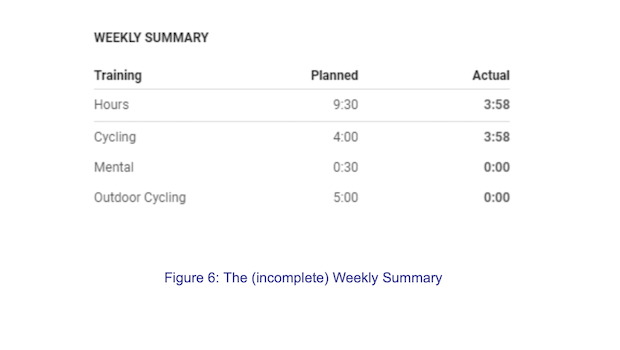
It shows that I had 9:30 planned – the sum of my indoor, outdoor, and mental training. But it shows 3:58 for actual even though I completed everything but the 30 minutes of mental training. I rode for about 8 hours on the weekend. What gives!?
SUF not only doesn’t let you download workouts to a head unit, but you also can’t import them from Strava or anywhere else, or even perform any manual entry beyond clicking a checkbox to mark an outdoor workout as “Done.” So the only indication you get that you did the workout is the box being green.. The all-green boxes for a week provides a bit of satisfaction. But for near-OCD types like myself, being told that you achieved less than half of what was planned certainly isn’t satisfying. SUF barely acknowledges any work you do outside the SUF app. Raced on Zwift? Doesn’t count. The summary of indoor metrics are bare-bones as well. You get hours. There is no display of weekly accumulated training stress as indicated by a Training Stress Score (TSS) or Chronic Training Load (CTL), etc.
If you’re looking for any detailed analysis beyond individual workout summaries or the progression of your 4DP values, look elsewhere. Though this article isn’t intended to be a direct comparison to TrainerRoad, it’s simply impossible to not recognize that TrainerRoad is, right now, unquestionably superior as a general-purpose analytical tool in most respects. That may change with an upcoming major release of the SUF app in the first quarter of 2021. Until then, data geeks like myself are forced to use Golden Cheetah, TrainingPeaks, TrainerRoad, Strava’s Premium features, or other analytical tools in conjunction with SUF.
Now let’s look at an individual workout, however, to see what SUF does offer that is different than those other tools. Here’s an upcoming workout of mine – Thin Air.
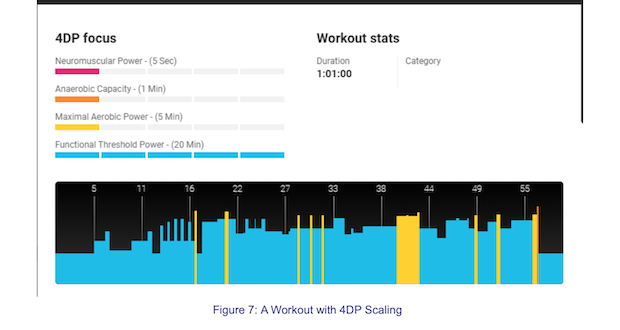
As is typical with indoor interval workouts, you get a nice color-coded graph showing the intervals, as well as a section showing what type of workout it is in the context of 4DP focus. This workout is mostly an FTP workout. The interesting part comes near the top, however – the four workout intensity scaling factors to the right of the “Coach notes.” This is where SUF is different in an interesting and possibly powerful way. While many indoor workouts are scaled by FTP, with the entire workout being scaled by one value – SUF scales by four different numbers – one for each 4DP profile value. In my workout here, the neuromuscular intervals are being left untouched, while the other three are being significantly scaled. Exactly how SUF scales is proprietary. But they do explain some of the reasons why and how the scaling occurs. Workouts are scaled to your individual strengths, weaknesses, and rider type. For example, my scaling above indicates my relatively weaker Anaerobic Capacity (AC). The workout scales that down, presumably so it’s at a level that *I* can manage.
That has a few benefits. First, when using a smart trainer, it has the immediate benefit of not putting me into constant risk of the “erg mode death spiral” on those efforts. The AC efforts, for me, will be within my genuine AC wheelhouse. And I’m thankful for this. There are few things more discouraging and frustrating in indoor cycling than being driven into a death spiral or assigned an effectively impossible-to-complete workout. One way to handle that in other apps is simply to scale the entire workout manually so that whatever intervals you’re doing are manageable. But that doesn’t work well if a workout has multiple interval types, and also without a principled way to choose the scaling value.. Another way is to revert from erg mode to level mode, and give your “best effort,” or use perceived exertion of heart-rate to govern your effort. But there’s value in the accountability of erg mode, and there’s also value in having the scaling factor calculated by genuine functional testing. This 4DP scaling is, to me, one of the most useful aspects of SUF, and maybe the least well known. Automatically prescribing manageable workout stress, both based on your own physiology and targeted to your specific strengths and weaknesses is a valuable feature.
I, For One, Welcome Our New Robot Overlords
SUF is not alone in this space. There are other apps that do similar things – some of them claiming use of artificial intelligence (AI). The principle is the same. Use measured training and performance data to tailor workouts and training plans that attempt to optimize for an individual athlete. With the goal of approaching or augmenting the expertise of a human coach. But whether the computation used to take the input data and produce an output is AI or just good, old fashioned non-AI computation is irrelevant. I don’t know how SUF does the scaling. I suspect it’s not AI. But I don’t really care. The SUF implementation makes intuitive sense, is easy-to-use, and is – in my opinion – effective. I understand what my 4DP results mean for me. I generally understand how and why it scales my workouts. I understand that changes in 4DP testing – say significantly improving my FTP – will result in my workouts changing, so that intervals of any type will continue to challenge me going forward. As my last article was about consistency, this approach to prescribing training in manageable doses is also about finding consistent progression in workouts over the long term. I don’t know if SUF will end up being the long-term winner of the emerging training plan robot wars. But what they’ve done so far seems intelligent and approachable – suitable for both recreational athletes and serious competitors. For my personal racing goals in 2021 (fingers crossed), SUF stands a reasonable chance to be a significant part of my testing and training plans.

